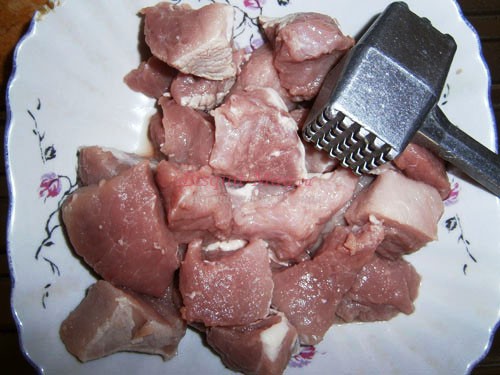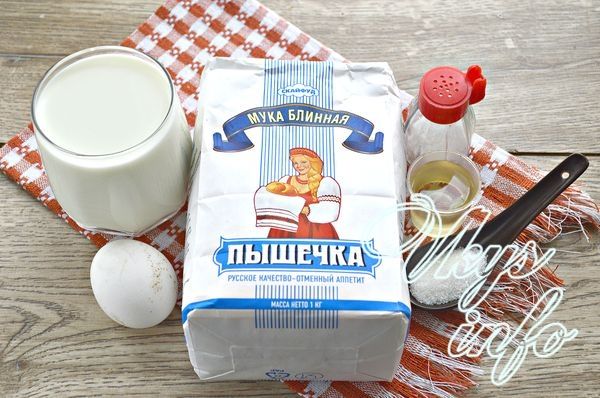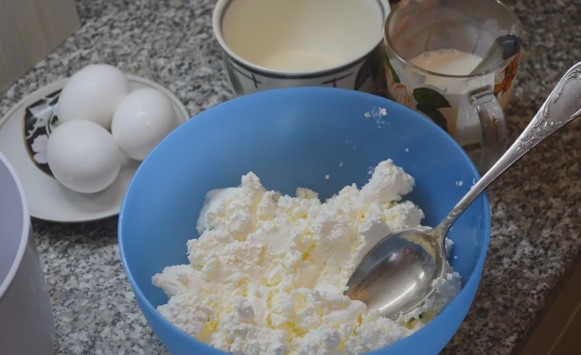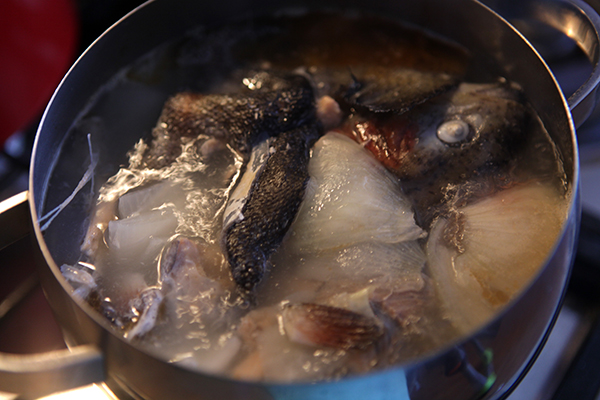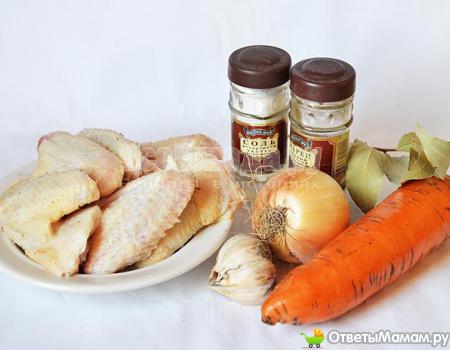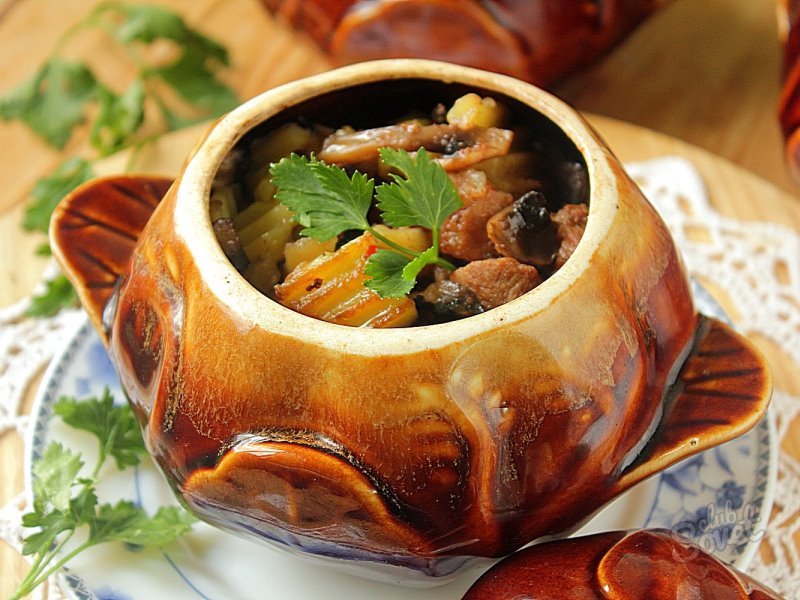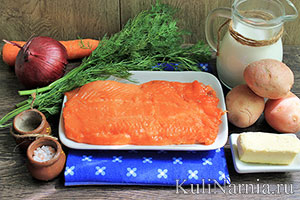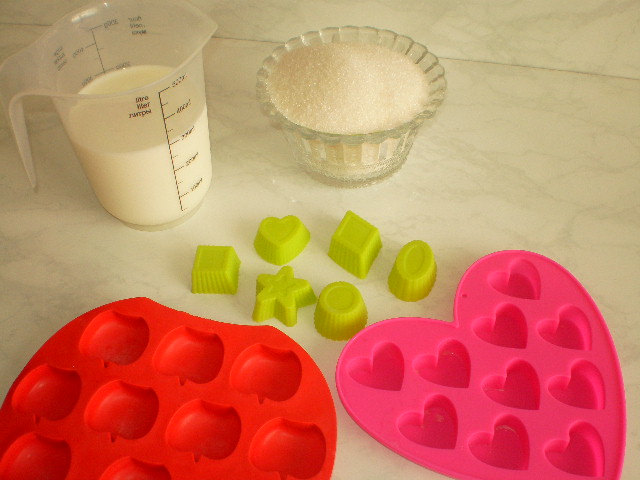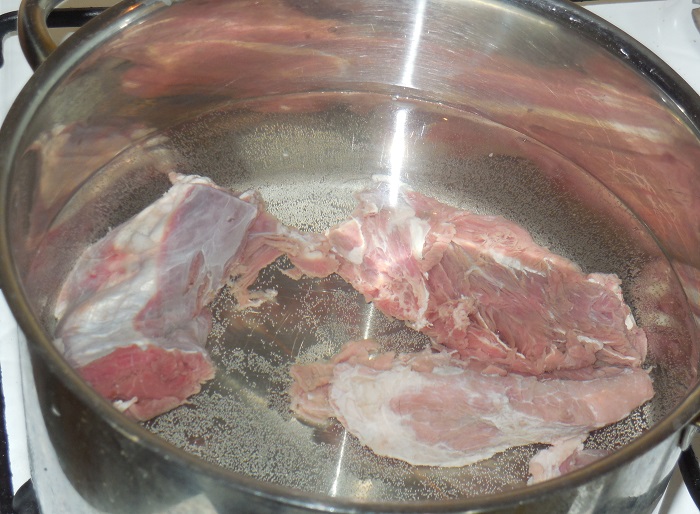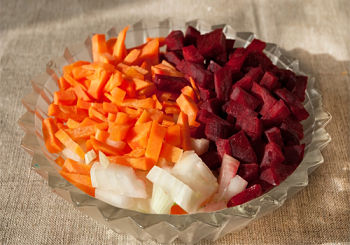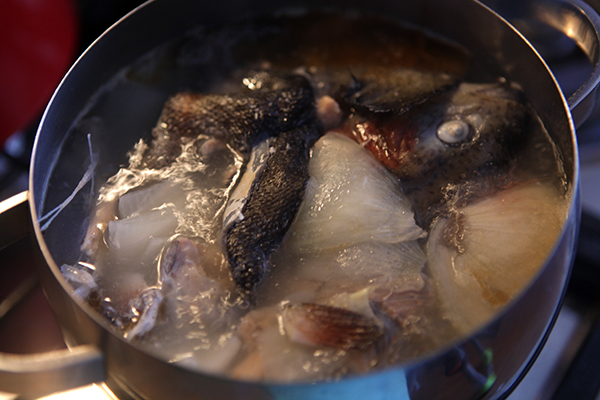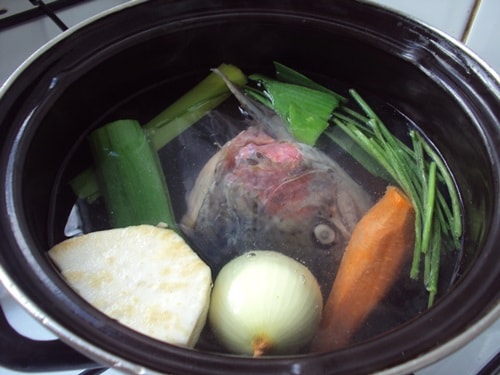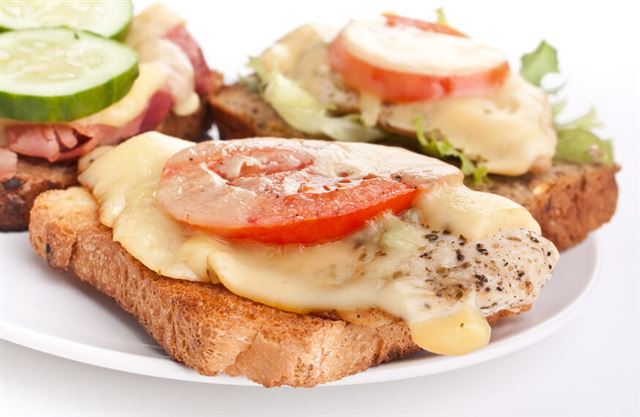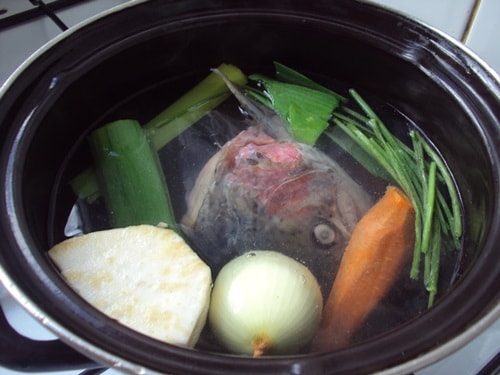Monastery pickles. Barrel Flavor
This is an old monastery cucumber pickling recipe. If you do not have red currants, you can safely cook without it by increasing the number of cucumbers. But I advise all the same to try and pickle cucumbers with currants - the taste is excellent!
Ingredients for 2 three-liter jars:
- 4 kg of cucumbers;
- 1 kg of red currant berries;
- 4 things. blackcurrant leaves;
- 4 things. cherry leaves;
- 1 large head of garlic;
- 100 g of dill stalks with umbrellas;
- 8 peas of black pepper;
- 8 clove buds.
For brine:
- 10 glasses (2 liters) of pure water (best of all - spring or filtered);
- 100 g of coarse salt (about 4 tbsp. L.);
- 50 g of granulated sugar (2 tbsp. L.).
Cooking:
- We prepare the cucumbers, as described above: rinse, soak, change the water several times.
- Berries of a currant we clear of twigs. Peel the garlic, divide into slices. Cut dill branches into strips about five centimeters long. Divide the leaves of cherries and currants one at a time. We rinse all the ingredients well, let the water drain.
- Scald with boiling water jars and caps. Prepare the brine: pour clean water into the pan, pour salt and sugar, mix. Heat to a boil.
- We spread half the components in each jar: dill, peppercorns, clove buds, currant leaves, cherries. Then comes a layer of cucumbers, lay on it the berries of currant and garlic cloves. So alternate layers almost to the top of the can. Cover with the remaining dill.
- Pour hot pickle into the cans. Cover with lids.
Note to the hostess: For reliability, the cans can be sterilized in a saucepan for 8-10 minutes. But I often cook without sterilization, and everything turns out fine, cucumbers do not explode.
Roll up the banks with the key, turn it over. Check if the fluid is leaking. Then wrap it with a warm towel or blanket.
After cooling, transfer our pickles to a cool place. After about three days, cucumbers can be served.
Monastery cucumbers for the winter with a simple pickle

Ingredients for 1 three-liter jar:
- 1.5 kg of cucumbers;
- 2 pcs. large leaves of horseradish;
- 2 pcs. blackcurrant leaves;
- 2 pcs. cherry leaves;
- 1 sprig of tarragon;
- 5 cloves of garlic;
- 5-6 dill umbrellas;
- 1 small pod of hot red pepper;
- 3 tbsp. l rock salt;
- 1 liter of pure water.
Cooking:
- Horseradish leaves give cucumbers a fortress. But, since the whole strength of horseradish leaves is in the petioles, we remove the leaf plate, and cut the petioles into pieces about 10 cm long. We will take umbrellas from dill, since the whole flavor of dill is in the umbrellas. You can also take dill stalks.
- Banks scalded with boiling water. In each three-liter jar we put 3 horseradish petioles, a couple of dill umbrellas, a tarragon sprig, 2 currant leaves, 2 cherry leaves, 3 slices of hot hot pepper, 5 peeled garlic cloves.
- For each 3 liter jar, we need 3 tbsp. tablespoons of rock salt with a slide. The salt is pre-soluble in a small amount of hot water. Let cool, but for now collect jars.
- We fill the jars tightly, but without effort - cucumbers, horseradish petioles, garlic. There should be a small space between the cucumbers so that they are well salted. Cut the garlic in half lengthwise.
- Fill the jar with cucumbers to the shoulders. We spread tarragon, dill umbrellas, bitter pepper, dill sticks on top. Fill with cold unboiled water about half. Water is clean and potable. Then pour in the cooled brine. Pour cold water to the top.
- We put each jar in a deep bowl so that the brine does not run away. Leave at room temperature for three days. Cucumbers should turn sour. Do not be alarmed by the cloudy appearance of the brine and the corresponding smell - it should be so.
- After 3 days, close the lid with holes, pour the brine into the pan. Put on fire, bring to a boil and cook literally a couple of minutes. Then the hot brine will again fill the ladle with a ladle. The brine should reach the top of the can. If suddenly not enough, top up with boiling water.
- We close the capron lid and store in a cool place. In two days, salting for the winter will be completely ready. Cucumbers will turn out so delicious, similar to barrel ones.
Enjoy your meal!!!
Salting cucumbers involves many ways, but I am very impressed with those that have come down to us from the depths of centuries. These recipes have been passed down from generation to generation, and they are now willingly used in monasteries when they prepare tasty and healthy food. Such a blank will pleasantly diversify your diet if you are fasting or “dieting”.
Tip: For salting, not all varieties of cucumbers are suitable, but special "pickles." You recognize them by the pimples on the skin. The fruits themselves are small, strong, juicy green. Do not take long and smooth vegetables of light color - these are salad varieties.
How to prepare cucumbers

Regardless of which preservation method you choose, cucumbers need to be processed first:
- Select fresh and strong vegetables, without damage. Rinse them, then soak them for several hours in cool water (it is best to withstand a time of 6-8 hours).
- Change the water several times so that the vegetables do not become acidic and remain elastic. Best of all - two to three times.
- And then rinse the cucumbers well again. This will be easy to do, because during soaking most of the dirt will leave the fruit. Thanks to this procedure, cucumbers after salting will turn out delicious and crispy.
And now we will go directly to the recipes of delicious monastery cucumbers in jars. I’ll tell you a little secret: in general, cucumbers were salted in wooden barrels or tubs in ancient monasteries. But the realities of modern life have allowed a little modification of this recipe. We will salt in the banks. Many monasteries are now doing that too.
Monastery salted cucumbers with red currants in jars

This is an old monastery cucumber pickling recipe. If you do not have red currants, you can safely cook without it by increasing the number of cucumbers. But I advise all the same to try and pickle cucumbers with currants - the taste is excellent!
- 4 kg of cucumbers;
- 1 kg of red currant berries;
- 4 things. blackcurrant leaves;
- 4 things. cherry leaves;
- 1 large head of garlic;
- 100 g of dill stalks with umbrellas;
- 8 peas of black pepper;
- 8 clove buds.
For brine:
- 10 glasses (2 liters) of pure water (best of all - spring or filtered);
- 100 g of coarse salt (about 4 tbsp. L.);
- 50 g of granulated sugar (2 tbsp. L.).
Cooking:
- We prepare the cucumbers, as described above: rinse, soak, change the water several times.
- Berries of a currant we clear of twigs. Peel the garlic, divide into slices. Cut dill branches into strips about five centimeters long. Divide the leaves of cherries and currants one at a time. We rinse all the ingredients well, let the water drain.
- Scald with boiling water jars and caps. Prepare the brine: pour clean water into the pan, pour salt and sugar, mix. Heat to a boil.
- We spread half the components in each jar: dill, peppercorns, clove buds, currant leaves, cherries. Then comes a layer of cucumbers, lay on it the berries of currant and garlic cloves. So alternate layers almost to the top of the can. Cover with the remaining dill.
- Pour hot pickle into the cans. Cover with lids.
Note to the hostess: For reliability, the cans can be sterilized in a saucepan for 8-10 minutes. But I often cook without sterilization, and everything turns out fine, cucumbers do not explode.
Roll up the banks with the key, turn it over. Check if the fluid is leaking. Then wrap it with a warm towel or blanket.
After cooling, transfer our pickles to a cool place. After about three days, cucumbers can be served.
Monastery cucumbers for the winter with a simple pickle

- 1.5 kg of cucumbers;
- 2 pcs. large leaves of horseradish;
- 2 pcs. blackcurrant leaves;
- 2 pcs. cherry leaves;
- 1 sprig of tarragon;
- 5 cloves of garlic;
- 5-6 dill umbrellas;
- 1 small pod of hot red pepper;
- 3 tbsp. l rock salt;
- 1 liter of pure water.
Cooking:
- Horseradish leaves give cucumbers a fortress. But, since the whole strength of horseradish leaves is in the petioles, we remove the leaf plate, and cut the petioles into pieces about 10 cm long. We will take umbrellas from dill, since the whole flavor of dill is in the umbrellas. You can also take dill stalks.
- Banks scalded with boiling water. In each three-liter jar we put 3 horseradish petioles, a couple of dill umbrellas, a tarragon sprig, 2 currant leaves, 2 cherry leaves, 3 slices of hot hot pepper, 5 peeled garlic cloves.
- For each 3 liter jar, we need 3 tbsp. tablespoons of rock salt with a slide. The salt is pre-soluble in a small amount of hot water. Let cool, but for now collect jars.
- We fill the jars tightly, but without effort - cucumbers, horseradish petioles, garlic. There should be a small space between the cucumbers so that they are well salted. Cut the garlic in half lengthwise.
- Fill the jar with cucumbers to the shoulders. We spread tarragon, dill umbrellas, bitter pepper, dill sticks on top. Fill with cold unboiled water about half. Water is clean and potable. Then pour in the cooled brine. Pour cold water to the top.
- We put each jar in a deep bowl so that the brine does not run away. Leave at room temperature for three days. Cucumbers should turn sour. Do not be alarmed by the cloudy appearance of the brine and the corresponding smell - it should be so.
- After 3 days, close the lid with holes, pour the brine into the pan. Put on fire, bring to a boil and cook literally a couple of minutes. Then the hot brine will again fill the ladle with a ladle. The brine should reach the top of the can. If suddenly not enough, top up with boiling water.
- We close the capron lid and store in a cool place. In two days, salting for the winter will be completely ready. Cucumbers will turn out so delicious, similar to barrel ones.
Crispy "Monastic" cucumbers from the father of Hermogenes

I have long wanted to learn how to make salted cucumbers in a monastic way from a priest. And now I was lucky - a friend went to a monastery near Ryazan and brought a wonderful old recipe from Hermogenes father. During a friend’s visit to the monastery, salting of cucumbers for the winter was in full swing there. The priest was helped by the cook of the monastery, Galina Kobzeva, who has been working there for 9 years. Cucumbers are cooked without vinegar, and the cooking method in its simplicity is not inferior to the previous one.
Ingredients for 1 three-liter jar:
- 2 kg of cucumbers;
- 2 l of pure water;
- 3 tbsp. l salts;
- 1 head of young garlic;
- 2 sheets of horseradish;
- 3-4 pcs. dill umbrellas.
Cooking:
- We wash the greens - dill, horseradish leaves, cherries and currants. Cut them large. Put in a clean jar.
- Then we take young garlic, cut, put on the bottom of the can. Then we take each cucumber, cut off the tips. We cut each fruit with a knife in two places in the middle, put it in a jar.
- We take large salt, stone - 3 tbsp. tablespoons of salt in a jar of 3 liters. We fill it with vegetables. Pour the cucumbers with cool water. Father takes water from the well. But you can take ordinary filtered water, but not boiled. Cover with four gauze folded. Leave for a couple of days to make them sour.
- On the 3rd day, pour the brine into the pan, bring it to a boil and pour the cucumbers. Close the lids. Any - even iron, at least plastic. Store in a cool, dark place. Here is such a simple recipe for cucumbers salted in a monastic way.
I like this method of salting because you do not need to sterilize the cans and add vinegar to the preservation. But most importantly - the cucumbers come out so crispy, tasting just like barrel. How nice to open a jar of such cucumbers in winter!
To see in detail how to pickle cucumbers in a monastic way, watch a great video.
Monastery salted cucumbers

Salted cucumbers are also very popular in the monastery refectory. Especially in June-July, when the cucumbers are very young. We will prepare them too.
Ingredients per 1 liter jar:
- 500-600 g of cucumbers;
- 2 tbsp. l salts;
- 3-4 cloves of garlic;
- A small bunch of fresh dill;
- 1 liter of filtered water.
Cooking:
- We wash the greens and cucumbers. Peel the garlic and divide into slices.
- We cut off the ends of the cucumbers, put them in a deep bowl.
- Finely chop the dill and sprinkle them with cucumbers.
- Squeeze the garlic into a bowl through a press. Sprinkle all with salt well.
- Then mix by hand, squeezing a little so that the vegetables slightly let the juice and soaked in garlic.
- Now put the vegetable mixture in a clean jar, fill it with cold water, close it with a plastic lid and put it in the refrigerator.
The next day, the light-salted cucumbers are ready!
Monastery effervescent cucumbers for the winter

Recently, an employee treated me to very unusual pickles, which she prepared according to a recipe brought from a pilgrimage trip. Cucumbers are called "effervescent" because of the peculiar taste. This time they are cooked with vinegar.
Tip: It is very important to put vinegar exactly as much as indicated, otherwise the "effervescence" will not work.
Ingredients for 2 three-liter jars:
- 4 kg of cucumbers;
- 2.5 liters of pure water;
- 80 g of salt;
- 280 g of granulated sugar;
- 400 ml of vinegar 9%;
- A bunch of spices for pickling cucumbers (dill umbrellas, horseradish leaves, tarragon);
- 1 head of garlic;
- 1 small pod of hot pepper.
Cooking:
- Soaked washed cucumbers for three hours in cold water. We change water every hour.
- Banks and lids scalded with boiling water. Put on the bottom of each jar a part of the dill umbrellas and horseradish leaves, tarragon, peeled and chopped garlic. Then we lay the cucumbers - first densely vertically, then horizontally to fit more.
- We will clear the hot peppers from seeds, wash them, cut into thin rings. Put in each jar, top cover with the rest of the greens.
- Prepare the marinade: pour water into the pan, add sugar and salt. Heat to a boil. Gently fill the cucumbers in jars with hot liquid, leave for three minutes.
- Then we put a lid with holes on the jar, pour the brine into the pan, heat it again and fill it for one minute. We repeat the procedure for the third time, pour cucumbers, leaving a place for vinegar on top.
- Now pour 200 ml of vinegar into each jar. If there is room, you can add the remaining brine. Roll up the lids, flip, wrap in a dense coverlet. Such preservation is well stored in the pantry.
These are simple and interesting monastic salted cucumber recipes in jars. I hope you enjoy them. Enjoy your meal!
Not all varieties of cucumbers are suitable for canning. There are those that are designed exclusively for salads. In canned form, they are poorly preserved, and not very tasty. Such varieties include, for example, Agate, Adam, Aelita, Biryusa, Graceful, Saltan. Salad varieties of cucumbers can be recognized by smooth skin without pimples.

Among the most famous varieties of cucumbers, ideally suited for canning, we can name three old varieties: Nezhinsky, Murom, Vyaznikovsky. Among the achievements of breeders of recent years, such varieties as Bochkova pickling, Aquarius, Vodograi, Pickling, Nezhenka, Nosovsky, Rodnichok, Ratibor, Nightingale, Crunchy, Era, Stage are distinguished. All of them are also recommended for canning.
Before canning, cucumbers must be carefully selected. They should be fresh, without damage, bright green (for some varieties green with a white barrel), without yellowness, the same size. Cucumbers need to be washed, soaked in cold water for 6-8 hours, during which time you need to change the water 2-3 times, then rinse again properly.
For pickling cucumbers according to the first recipe, we need a wooden barrel, a wooden circle and oppression. New, not yet used barrels and wooden mugs for oppression are prepared in advance, this can take more than two weeks.
The barrel and the circle are first scalded, then poured with cold water and soaked for two weeks. Then it is thoroughly washed first with hot, then with cold water without the use of soap and cleaning products. This is necessary to swell the barrel (otherwise it will flow) and wash out excess tannins (otherwise the product inside the barrel will turn brown).
Instead of a wooden mug for oppression, you can use an enamelled (without chips and damage) or stainless steel pan lid, as well as a wide and thick flat plate.
Stones suitable for oppression are granite, flint, previously washed and drenched in boiling water. You can not use limestone, because when interacting with brine, they form harmful compounds. Instead of stones in a home environment, you can use a glass jar filled with cold water, or a weight wrapped in cling film so that the metal does not interact with the brine.
It is better to use pure spring water or drinking water - boiled and chilled.

Pickled Cucumbers
Required: wooden barrel, wooden circle, oppressed
For 1 barrel with a capacity of 50 l:
Cucumbers 4 buckets with a capacity of 10 l (the number of cucumbers is given in liters, not in kilograms, since it is more convenient to calculate the required number of cucumbers to fill the barrel)
Dill stalks with umbrellas 2 kg
Garlic 300 g
Horseradish root 300 g
Horseradish leaves 300 g
A mixture of oak, cherry, blackcurrant, tarragon leaves in any proportions 300 g
For brine:
Cold water 25 l
Coarse salt 2 kg
1. Prepare the brine: dissolve the salt in water, mix.
2. Peel the garlic. Rinse the horseradish root and cut into plates. Wash the leaves. Garlic, dill, horseradish and leaves are divided into three parts.
3. Lay the first part to the bottom of the prepared barrel. Then lay the cucumbers in dense layers, shifting them with spices (use the second part). Cover the last layer of cucumbers with the remaining spices.
4. Pour the brine so that it covers the cucumbers. Lay a wooden circle, set the oppression on top.
5. Keep the barrel in a relatively warm place (not higher than 20 ° C) for 1-2 days, then put it in the cellar or on the glacier, where to store. Storage temperature should be positive.
Time for preparing: 2 hours + aging for at least 1 week.

Pickles
Cucumbers 4 kg
Hot pepper (red) 2 pcs.
Garlic 2 heads
Horseradish leaves 2 pcs.
Cherry or blackcurrant leaves 4 pcs.
Black pepper peas 2 tsp.
Bay leaf 8 pcs.
Clove 8 pcs.
For marinade:
Water 10 cups (2 L)
Coarse salt 6 tbsp. l (150 g)
Vinegar 9% 2 cups (400 ml)
Sugar 4 tbsp. l (100 g)
2. Prepare the marinade: mix water, salt, sugar and vinegar, bring to a boil.
3. Rinse hot peppers.
4. Peel the garlic.
5. Cut horseradish leaves, leave the remaining leaves intact.
8. At the bottom of the cans, put half the specified amount of pepper, peas, cloves, bay leaf and herbs. Then, alternating, lay the cucumbers and cloves of garlic. Add pods of hot pepper to each jar. Lay the remaining herbs and spices on top.
9. Pour the marinade to the very top so that there is no air left, cover the banks with lids.
10. Sterilize banks. After sterilization, the cans are hermetically sealed, flipped, cooled. Store in a cool dark place.
Time for preparing: 2 hours + availability from 3 days.

Redcurrant cucumbers
Required: lid rolling machine, glass jars, lids
At 6 L (2 cans with a capacity of 3 L):
Cucumbers 4 kg
Redcurrant berries 1 kg
Garlic 1 head
Dill stalks with umbrellas 100 g
4 pieces of cherry and blackcurrant leaves
Black pepper peas
Clove 8 pcs.
For brine:
Water 10 cups (2 L)
Coarse salt 4 tbsp. l (100 g)
Sugar 2 tbsp. l (50 g)
1. Sort cucumbers, rinse, soak in cold water for 8 hours, during which time 2-3 times change the water, then rinse again properly.
2. Prepare the brine: dissolve the salt and sugar in water, bring to a boil.
3. Peel the garlic.
4. Rinse the berries in cold water and clear of twigs.
5. Rinse the leaves of cherries and currants in cold water.
6. Dill cut across the pieces with a length of not more than 5 cm.
7. Sterilize jars and lids.
8. At the bottom of the cans, put half the specified amount of dill, pepper, peas, cloves, leaves. Then, alternating, lay cucumbers, currants and cloves of garlic. Put the remaining herbs and spices on top.
9. Pour boiling brine, cover the banks with lids. Sterilize banks.
10. After sterilization, the cans are hermetically sealed, flipped, cooled.
Store in a cool dark place.
Time for preparing: 2 hours + aging from 3 days.
Oleg Olkhov
In order for the conservation process to go smoothly and easily, you need to free it all day in advance. You should also buy cans, lids, all the necessary spices (and this is not just salt) in advance, then just follow the described recipes, and the seaming in your cellar will become more and more. You can still do it.
Monastery cucumbers (per liter jar)
What do you need:
- A few kg of cucumbers;
- Dill umbrellas, in which there are already ripened seeds;
- Five sheets of cherries;
- Two bay leaves;
- Black pepper peas;
- Large garlic tooth;
Per liter of marinade:
- Two tbsp. tablespoons of salt;
- Two tbsp. tablespoons of sugar;
- Two tbsp. tablespoons of vinegar;
Rinse cucumbers in ice water and leave in this water for two hours. This step should not be neglected, because, otherwise, cucumbers will not be crispy. While the fruits are soaked, the cans need to be cleaned with soda, thoroughly washed and sterilized. Also, do not forget that tin lids also require sterilization.
Rinse the greens well and arrange it in prepared jars. If you have lush greenery, then it’s easier to focus on 10%. This means that greens should not occupy more than 10% of each jar. Spices, unlike herbs, are placed at the last moment, so that you can put them off for now. Put the cucumbers in jars in an upright position. Then bring the water to a boil, dissolve the bulk ingredients for the marinade in it. Pour water into the cucumbers with herbs, cover and let stand a little.
Then pour the water back into the pan, add another 100 ml of water, put spices and boil for five minutes. Pour cucumbers to the brim with brine, pour over a spoonful of vinegar and roll up the lids. Cool down send on a hard surface upside down, cover with a blanket.
Recipe with vodka (without vinegar)
We have already considered an interesting option, cucumbers for the winter in jars of vinegar. But many modern housewives are cautious about vinegar and do not want to use this ingredient for canning. Well, it can be successfully replaced.
What do you need:
- Cucumbers 2 kg;
- 2 tbsp. tablespoons of salt and sugar;
- Two medium heads of peeled garlic;
- A small spoon of citric acid;
- 50 ml of vodka;
- One and a half liters of clean drinking water;
- Greens, here you can choose any green at your own discretion;
- Spices are also chosen at one’s own discretion, who, who loves more;
Rinse the fruits and soak for a couple of hours in ice water. Well, if you manage to change the water, then the cucumbers will be as crisp as possible. 3 L jar and prepare a lid for her for a roll. Add herbs, garlic, spices. Then tightly lay the cucumbers in the jar.

To boil the marinade, salt and sugar, citric acid dissolve in boiling water. Pour boiling marinade into cucumbers, leave for a dozen minutes. Then pour the same solution into the pan again, boil again, this time add water. That's all, now pour the brine into the cucumbers to the top, roll up the lids and put on cooling upside down. It didn’t seem to you, pickled cucumbers according to the given recipe do not need to be pickled.
Lightly salted
The next option, how to preserve cucumbers for the winter in jars (with video), talks about how in the winter you will get cucumbers that taste similar to light-salted options. Cucumbers are taken in the quantity that is. To use grass also at own discretion, as well as spices.
Not quite standard ingredients are taken for brine. It takes three liters of water, a glass of salt. Dissolve the salt in water and bring to a boil. Pour cucumbers with herbs and spices in a jar with brine, which boils. Leave for two days: the fermentation process should begin. Next, drain the brine into the sink: it will no longer be needed. Pour cucumbers with clean boiling water and roll up with sterile lids.

Barrel
Cucumbers will need to be salted for five days in saline. Then, boil the brine three times, each time pour it into jars for 10 minutes. The subtlety is that cucumbers should be stored in a warm place, otherwise they can become acidic.
For five kg of the product you will need a dill with an umbrella, leaves and horseradish root, a leaf of black currant and oak. You can add garlic, allspice and even a pod of chili. For the preparation of brine, a dozen tablespoons of salt are taken per 350 ml of water.
These methods are suitable for preserving in jars. As you can see, in the process of preserving cucumbers there is absolutely nothing complicated and you should not be afraid of this process. It is necessary to prepare everything in advance, free up time and engage in culinary creativity.
Dear Universe! Please make sure that in the spring and summer there are 30 hours in the day and 18 in the winter;) Well, in fact - I want to do so much, but I can’t squeeze all my Wishlist into the usual 24 hours.
The picture outside the window is constantly changing - that’s how I photographed something, I didn’t have time to show it, you look, but after a couple of days it was no longer relevant ... Time flies just at a crazy speed - it would seem that recently snowdrops blossomed, and now the daffodils are blooming, the flowering of peach and apricot has been replaced by cherries and pears, and strawberries are already in full bloom. And soon all this will begin to bear fruit sooner) and the time will come for harvesting and there already autumn is just around the corner)
I’m one of those people who can’t refuse preparations in any way - no one can convince me that store preservation is tastier, and there’s nothing to waste precious time on salt, ferment, pickle, etc. We always loved pickles, pickled tomatoes, sauerkraut, pickled and pickled mushrooms, etc. etc., therefore, despite the fact that the Kuban winter is not at all as long as the northern one, and the fresh vegetable season is much longer, there should be blanks in my pantry! And for those who, just like me, can’t imagine their table without crispy cucumbers and fragrant strawberry jam, I’ll tell you about Oleg Olkhov’s book “Monastic Preparations”. I already spoke about one of O. Olkhov’s books recently, so I won’t talk about the author for a long time, I’ll just say that I really like his recipes, so I took the book on blanks without a doubt. I must say right away - if you want to find some new-fangled recipes here, then this book is not for you - there are no pickles, no chutneys, or other exotic ones. There are well-known, good-quality recipes - jam from cherries, raspberries, plums, etc. Soaked apples and berries, salted and pickled vegetables, pastille, salted saffron mushrooms and mushrooms, pickled mushrooms. Many recipes are well known, and practically do not differ from those used by my mother and grandmother, according to which I cook, and which have never failed.
As in other books of O. Olkhov, this one contains not only recipes, but also a story about fasting and holidays falling out during the summer period, about dishes that are associated with them. "This book, in fact, is about fasting dishes that we often eat during the days of Petrov and Uspensky fasting. After all, not all vegetables are ripened in July and August, young apples are not consecrated, so we are satisfied with soaked apples and pears of the last harvest and are pulled out cellars last cans with pickles, tomatoes, peppers, mushrooms to make way for a new crop. "
The book has three sections: Introduction (on church holidays)
Prepared vegetables and mushrooms (30 recipes)
Berry and fruit blanks (17 recipes)
As in other books of the author, very beautiful photographs of not only dishes, but also churches, monasteries. In general, I recommend to anyone involved in harvesting
And a few turns:













